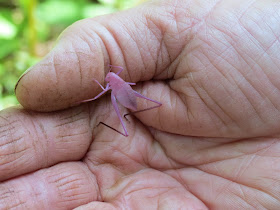So I had B out there with me for reinforcement and another pair of eyes as we cut. (But he has probably learned not to stand behind me in these situations!)
What my eyes found was not a snake--- but even more shocking: a pink katydid.
B discovered a second one while I was taking pictures.
I did a little research and sent the pictures to an entomologist who found them interesting, too. From him I learned that this is most likely the color these will be throughout all of their life stages and that it has nothing to do with their diet. It is called erythrism, meaning odd pink colors that show up occasionally in animals. This is related to a recessive gene, similar to albinoism. Pink katydids were first described in 1887 and are said to be as rare as 1 in 500, which does not actually sound all that rare to me!
I also learned that with katydids, unlike with crickets and cicadas, both male and females make noises by rubbing their hind legs together. In those other insects, only the males make sounds. They hear with ears on their front legs! Imagine if our bodies were designed that way: pants would need ear holes.
I also learned that with katydids, unlike with crickets and cicadas, both male and females make noises by rubbing their hind legs together. In those other insects, only the males make sounds. They hear with ears on their front legs! Imagine if our bodies were designed that way: pants would need ear holes.
I already said we were gardening: hands get dirty when you garden!
One in the hand is worth two in the bush!
I went back the next night and caught one and put it in a jar and took it to school with food. Folks were amazed. I said to the art teacher, "If we were told to color a katydid, how many of us would think to make it pink?" After determining that the University of Florida did not need it for research, I decided that we can grow enough plants for the pink katydids to eat and us to enjoy as well: I put it back where I found it.






No comments:
Post a Comment